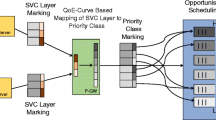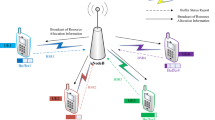Abstract
A green cellular technology is proposed to optimize the energy and spectrum resources. Such optimization will require perfect channel state information at the transmitting base station. However, reporting the channel status of the entire bandwidth requires huge undesirable feedback overhead. Therefore, the aim of this paper is to optimize the energy and bandwidth resources while maintaining quality-of-service at the downlink when a partial feedback is considered. In this paper, a modified downlink scheduler based on a Packet Prediction Mechanism (PPM) is conducted at the eNodeB to optimize the energy and spectrum resources. On the user equipment side, a partial channel feedback scheme based on an adaptive feedback threshold is developed. A primary concern of this feedback scheme is to reduce the uplink signaling overhead without a substantial loss in downlink performances. Finally, the downlink packet scheduling and the partial feedback are jointly evaluated to further enhance the system performance. Based on a system-level simulation results, the proposed energy-efficient scheduling with partial feedback has achieved an improvement in EE of up to 79% compared to the PPM scheduler. Besides, it minimizes the degradation caused by the partial channel quality indicator feedback. Thus, the proposed two-sided algorithm gives the best tradeoff between uplink and downlink performances.







Similar content being viewed by others
References
Europe, E.-T. (2007). Green issues challenge base station power. September 19, 2007.
Han, C., et al. (2011). Green radio: Radio techniques to enable energy-efficient wireless networks. IEEE Communications Magazine, 49(6), 46–54.
Chen, H., Cai, Y., & Wu, D. (2015). Joint spectrum and power allocation for green D2D communication with physical layer security consideration. KSII Transactions on Internet and Information Systems (TIIS), 9(3), 1057–1073.
Miao, G., et al. (2008). Energy efficient design in wireless OFDMA. In IEEE international conference on communications, 2008. ICC’08.
Miao, G., Himayat, N., & Li, G. Y. (2010). Energy-efficient link adaptation in frequency-selective channels. IEEE Transactions on Communications, 58(2), 545–554.
Videv, S., et al. (2012). Resource allocation for energy efficient cellular systems. EURASIP Journal on Wireless Communications and Networking, 2012(1), 181.
Han, C., & Armour, S. (2011). Energy efficient radio resource management strategies for green radio. IET Communications, 5(18), 2629–2639.
Xiong, C., et al. (2011). Energy-and spectral-efficiency tradeoff in downlink OFDMA networks. In IEEE international conference on communications (ICC) 2011. Atlanta, GA.
Tang, T., & Heath, R. W. (2005). Opportunistic feedback for downlink multiuser diversity. IEEE Communications Letters, 9(10), 948–950.
Chen, J., Berry, R. A., & Honig, M. L. (2008). Limited feedback schemes for downlink OFDMA based on sub-channel groups. IEEE Journal on Selected Areas in Communications, 26(8), 1451–1461.
Donthi, S. N., & Mehta, N. B. (2011). An accurate model for EESM and its application to analysis of CQI feedback schemes and scheduling in LTE. IEEE Transactions on Wireless Communications, 10(10), 3436–3448.
Video trace library (online). Available from: http://trace.eas.asu.edu/
Donthi, S. N., & Mehta, N. B. (2011). Joint performance analysis of channel quality indicator feedback schemes and frequency-domain scheduling for LTE. IEEE Transactions on Vehicular Technology, 60(7), 3096–3109.
Hartley, R. V. (1928). Transmission of information. Bell System Technical Journal, 7(3), 535–563.
Heliot, F., Imran, M. A., & Tafazolli, R. (2012). On the energy efficiency-spectral efficiency trade-off over the MIMO Rayleigh fading channel. IEEE Transactions on Communications, 60(5), 1345–1356.
Sivridis, L., & He, J. (2013). A strategy to reduce the signaling requirements of CQI feedback schemes. Wireless Personal Communications, 70(1), 85–98.
Lai, W. K., & Tang, C.-L. (2013). QoS-aware downlink packet scheduling for LTE networks. Computer Networks, 57(7), 1689–1698.
Opricovic, S., & Tzeng, G.-H. (2004). Compromise solution by MCDM methods: A comparative analysis of VIKOR and TOPSIS. European Journal of Operational Research, 156(2), 445–455.
Yoon, K. P., & Hwang, C.-L. (1995). Multiple attribute decision making: An introduction (Vol. 104). Thousand Oaks: Sage Publications.
Del Valle, Y., et al. (2008). Particle swarm optimization: Basic concepts, variants and applications in power systems. IEEE Transactions on Evolutionary Computation, 12(2), 171–195.
Shi, Y., & Eberhart, R. (1998). Parameter selection in particle swarm optimization. In V. W. Porto et al. (Eds.), Evolutionary programming VII (pp. 591–600). Berlin: Springer.
Piro, G., et al. (2011). Simulating LTE cellular systems: An open-source framework. IEEE Transactions on Vehicular Technology, 60(2), 498–513.
Camp, T., Boleng, J., & Davies, V. (2002). A survey of mobility models for ad hoc network research. Wireless Communications and Mobile Computing, 2(5), 483–502.
3GPP. (2011). Group Radio Access Network; Evolved Universal Terrestrial Radio Access (E-UTRA) and Evolved Universal Terrestrial Radio Access Network (E-UTRAN); Radio Frequency (RF) system scenarios (Release 10), 3GPP TS 36.942.
Ali-Yahiya, T. (2011). Understanding LTE and its performance. Berlin: Springer.
Acknowledgements
This research is supported by the Fundamental Research Grant Scheme (FRGS), Project: FP007-2016 from Ministry of Higher Education, Malaysia.
Author information
Authors and Affiliations
Corresponding author
Rights and permissions
About this article
Cite this article
Salman, M.I., Mansoor, A.M., Jalab, H.A. et al. A Joint Evaluation of Energy-Efficient Downlink Scheduling and Partial CQI Feedback for LTE Video Transmission. Wireless Pers Commun 98, 189–211 (2018). https://doi.org/10.1007/s11277-017-4863-2
Published:
Issue Date:
DOI: https://doi.org/10.1007/s11277-017-4863-2




